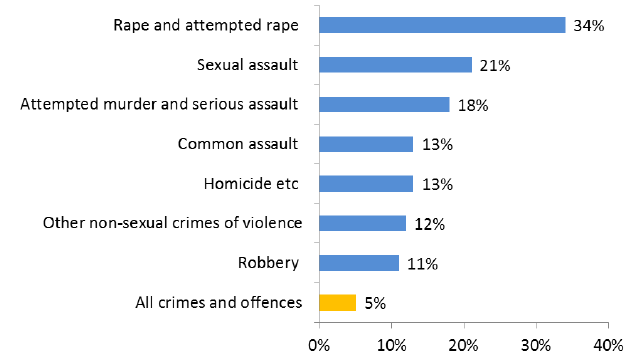CRIMINAL PROCEEDINGS IN SCOTLAND 2014-15
Summary of offences dealt with by courts, sentencing outcomes and characteristics of convicted offenders. Additional information on non-court penalties issued by the Police and Crown Office & Procurator Fiscal Service.
2. Acquittals
Eighty-six per cent of people proceeded against in court in 2014-15 were convicted after being found guilty of at least one charge (106,507 people), one percentage point lower than in 2013-14. Five per cent were acquitted on a ‘not guilty’ verdict, and around 1 per cent were acquitted on a ‘not proven’ verdict. The remaining 8 per cent either had a plea of ‘not guilty’ accepted or their case deserted by the prosecution. These proportions are broadly the same as in 2013-14.
Chart 4 shows that acquittal rates for “not guilty” vary by crime type in comparison with the overall rate of 5 per cent in 2014-15 as follows:
- The highest rate was seen for rape and attempted rape, where 34 per cent or 92 people of the 270 proceeded against were acquitted on a ‘not guilty’ verdict;
- Sexual assault (21 per cent) and serious assault and attempted murder (18 per cent) also had high acquittal rates in 2014-15 compared to the other crimes and offences;
- There were relatively high acquittal rates for common assault and robbery, 13 and 11 per cent respectively compared to 5 per cent for all crimes and offences.
Chart 4: Crime types with the highest “not guilty” acquittal rates

The proportion of people receiving a ‘not proven’ verdict in 2014-15 was also highest for rape and attempted rape (19 per cent), followed by sexual assault (11 per cent). Twenty-six per cent of people proceeded against for theft of a motor vehicle had a plea of not guilty accepted or had the case against them deserted, the highest proportion of all crime groups.
Contact
Email: Gillian Diggins
There is a problem
Thanks for your feedback